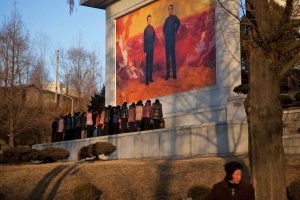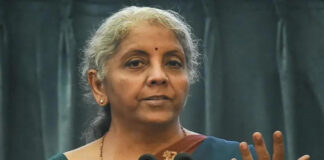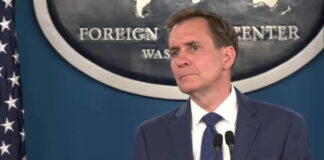AUGUST 15, 2018
 North Koreans stand before a roadside mosaic of Kim Il Sung and Kim Jong Il to pay their respects to the dead leaders. Kim Jong Il died in 2011, Kim Il Sung in 1994. – David Guttenfelder, AP
North Koreans stand before a roadside mosaic of Kim Il Sung and Kim Jong Il to pay their respects to the dead leaders. Kim Jong Il died in 2011, Kim Il Sung in 1994. – David Guttenfelder, AP
SEOUL – South Korean President Moon Jae-in called for a single economic community between North and South Korea on Wednesday, saying that closer railway, energy and economic cooperation would bring peace and prosperity to Northeast Asia.
Moon said that the first step would be to physically reconnect road and rail connections with North Korea by the end of the year. He spoke at a ceremony marking South Korea’s independence from Japanese rule in 1945.
Moon also proposed the creation of an “East Asian Railroad Community,” which would connect the two Koreas, China, Japan, Russia and Mongolia and would turn into an energy and economic bloc that would include the United States.
“We must overcome division for our survival and prosperity,” Moon said. “Even though political unification is still far away, building a single economic community first by settling peace and freely traveling back and forth between the two Koreas will become genuine liberation for us.”
Moon, who has made improved ties with Pyongyang a key focus since taking office in May 2017, noted that the European Union first began as a coal and steel community and said that improved economic ties would help push the peace process forward.
“Peace and the economy are synonymous,” he said.
Moon has also pushed for restarting economic projects such as the Kaesong Industrial Complex in North Korea, a manufacturing park located six miles north of the heavily armed border between the two countries.
Kaesong park opened in 2004 and South Korean businesses employed over 50,000 North Koreans to make clothing and electronics there before it was shuttered in 2016 as retaliation for North Korean missile and nuclear tests.
Moon estimated that cross-border economic cooperation would generate at least $150 billion over the next 30 years, citing a study by a state-run think tank.
However, he said that economic cooperation cannot be carried out “in earnest” until the complete denuclearization of the Korean Peninsula – and peace – are established.
Moon said that he would take an “audacious step” towards those goals when he visits Pyongyang next month for talks with North Korean leader Kim Jong Un. It will be the third time the two leaders meet in a series of diplomatic engagements that began with their summit in the border village of Panmunjom in April.
However, any plan for economic cooperation in North Korea is severely limited by United Nations sanctions that limit trade with the communist nation. The sanctions were imposed in December 2017 in reaction to the North’s nuclear weapons program.
between President Donald Trump and Kim in Singapore in June produced an agreement that committed “to work toward complete denuclearization of the Korean Peninsula,” but provided few details of how that could work. Last week, National Security Adviser John Bolton slammed North Korea, saying the country has “not taken the steps we feel are necessary to denuclearize.” Washington has insisted that sanctions will not be lifted until complete denuclearization.
North Korea said last week that it had stopped nuclear and missile tests, dismantled a nuclear test ground and killed in the 1950-53 Korean War.
Pyongyang called on the U.S. to reciprocate its “goodwill measures” by easing sanctions and claimed that Washington was following an “outdated acting script.”
In Tuesday’s speech, Moon called on the United States and North Korea to cooperate to move the peace process forward. “I hope that the implementation of the complete denuclearization of North Korea and corresponding comprehensive measures by the United States will be pursued quickly,” he said.
Once peace is established, Moon said that other economic projects would be pursued, including the creation of special economic zones in South Korean provinces that border the North.
Courtesy: USA Today

































































































